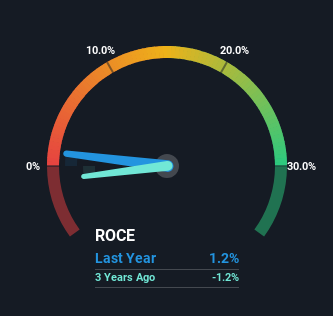Some Investors May Be Worried About S&P International Holding's (HKG:1695) Returns On Capital

If you're looking at a mature business that's past the growth phase, what are some of the underlying trends that pop up? More often than not, we'll see a declining return on capital employed (ROCE) and a declining amount of capital employed. Trends like this ultimately mean the business is reducing its investments and also earning less on what it has invested. In light of that, from a first glance at S&P International Holding (HKG:1695), we've spotted some signs that it could be struggling, so let's investigate.
What Is Return On Capital Employed (ROCE)?
For those that aren't sure what ROCE is, it measures the amount of pre-tax profits a company can generate from the capital employed in its business. To calculate this metric for S&P International Holding, this is the formula:
Return on Capital Employed = Earnings Before Interest and Tax (EBIT) ÷ (Total Assets - Current Liabilities)
0.012 = RM1.6m ÷ (RM173m - RM35m) (Based on the trailing twelve months to December 2022).
So, S&P International Holding has an ROCE of 1.2%. In absolute terms, that's a low return and it also under-performs the Food industry average of 8.0%.
See our latest analysis for S&P International Holding

While the past is not representative of the future, it can be helpful to know how a company has performed historically, which is why we have this chart above. If you'd like to look at how S&P International Holding has performed in the past in other metrics, you can view this free graph of past earnings, revenue and cash flow.
What Can We Tell From S&P International Holding's ROCE Trend?
We are a bit worried about the trend of returns on capital at S&P International Holding. About five years ago, returns on capital were 16%, however they're now substantially lower than that as we saw above. On top of that, it's worth noting that the amount of capital employed within the business has remained relatively steady. Companies that exhibit these attributes tend to not be shrinking, but they can be mature and facing pressure on their margins from competition. If these trends continue, we wouldn't expect S&P International Holding to turn into a multi-bagger.
On a side note, S&P International Holding's current liabilities have increased over the last five years to 20% of total assets, effectively distorting the ROCE to some degree. Without this increase, it's likely that ROCE would be even lower than 1.2%. Keep an eye on this ratio, because the business could encounter some new risks if this metric gets too high.
In Conclusion...
All in all, the lower returns from the same amount of capital employed aren't exactly signs of a compounding machine. We expect this has contributed to the stock plummeting 78% during the last five years. With underlying trends that aren't great in these areas, we'd consider looking elsewhere.
If you'd like to know about the risks facing S&P International Holding, we've discovered 2 warning signs that you should be aware of.
For those who like to invest in solid companies, check out this free list of companies with solid balance sheets and high returns on equity.
If you're looking to trade S&P International Holding, open an account with the lowest-cost platform trusted by professionals, Interactive Brokers.
With clients in over 200 countries and territories, and access to 160 markets, IBKR lets you trade stocks, options, futures, forex, bonds and funds from a single integrated account.
Enjoy no hidden fees, no account minimums, and FX conversion rates as low as 0.03%, far better than what most brokers offer.
Sponsored ContentNew: Manage All Your Stock Portfolios in One Place
We've created the ultimate portfolio companion for stock investors, and it's free.
• Connect an unlimited number of Portfolios and see your total in one currency
• Be alerted to new Warning Signs or Risks via email or mobile
• Track the Fair Value of your stocks
Have feedback on this article? Concerned about the content? Get in touch with us directly. Alternatively, email editorial-team (at) simplywallst.com.
This article by Simply Wall St is general in nature. We provide commentary based on historical data and analyst forecasts only using an unbiased methodology and our articles are not intended to be financial advice. It does not constitute a recommendation to buy or sell any stock, and does not take account of your objectives, or your financial situation. We aim to bring you long-term focused analysis driven by fundamental data. Note that our analysis may not factor in the latest price-sensitive company announcements or qualitative material. Simply Wall St has no position in any stocks mentioned.
About SEHK:1695
S&P International Holding
An investment holding company, engages in manufacturing and distributing coconut-based food and beverage products.
Flawless balance sheet with acceptable track record.
Similar Companies
Market Insights
Community Narratives



